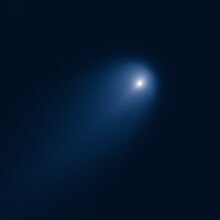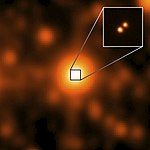User:TheAustinMan/sandbox/Comet ISON
 Comet ISON as imaged by TRAPPIST on 15 November 2013 | |
| Discovery | |
|---|---|
| Discovery date | Vitaly Nevsky and Artyom Novichonok at ISON-Kislovodsk, Russia using a 0.4-m reflector (D00) |
| Orbital characteristics | |
| Epoch | 14 December 2013 (JD 2456640.5) |
| Perihelion | 0.01244 AU (q) |
| Eccentricity | 0.9999947 1.0002 (epoch 2050) |
| Orbital period | Ejection trajectory (epoch 2050) |
| Max. orbital speed | 680,000 km/h (420,000 mph) |
| Inclination | 62.4° |
| Last perihelion | 28 November 2013 |
Comet ISON, formally designated as C/2012 S1,[nb 1] was a highly anticipated sungrazing comet that largely broke up during its perihelion in late November 2013 after reaching naked eye visibility in mid-November of that year. The comet was discovered on 21 September 2012 by Vitali Nevski (Виталий Невский, Vitebsk, Belarus) and Artyom Novichonok (Артём Новичонок, Kondopoga, Russia) using the 0.4-meter (16 in) reflector of the International Scientific Optical Network (ISON) near Kislovodsk, Russia, and later confirmed by unaffiliated observers. Early projections indicated that the comet would pass very close to the sun, and given its unusually distant discovery position beyond the orbit of Jupiter, would become very bright. In addition, its trajectory suggested that ISON had likely originated from the Oort cloud and would be making its first traversal of the Inner Solar System. Several observing campaigns were formed and several spacecraft were set to periodically observe the comet in premonition for its approach. Following discovery, the comet was precovered in images taken as far back as December 2011. Though the comet's nucleus was initially estimated to be much larger, more refined estimates indicated that ISON's nucleus was smaller than 0.8 km (0.5 mi) shortly before perihelion.
For the first few months following discovery, the comet remained well below the threshold for naked eye visibility but was dispersing an unusually large amount of dust and other materials. Throughout the first half of 2013, spacecraft and ground observatories regularly observed ISON, though the comet was lost in the sun's glare for Earth-based observers from June to August 2013. After reemergence, Comet ISON continued to steadily brighten, but for a period of time beginning in October brightening stagnated, indicative a decrease in material output. However, in mid-November, ISON suddenly went through an outburst, brightening by roughly two magnitudes and becoming visible to the naked eye. The comet steadily brightened in the following days, and entered the field of view of SOHO imagery on 27 November. Despite continued brightening, the comet did not brighten as much as previously forecast, and at the time of perihelion, dimmed slightly and could not be imaged up by the Solar Dynamics Observatory; as such the comet was largely believed to have disintegrated in the sun's corona. However, images later revealed that at least portions of the comet's nucleus remained intact after perihelion. These remnants later diffused into a cloud of cometary matter. Regardless of whether or not ISON remains an intact nucleus, its associated remnants are currently in a hyperbolic trajectory and are not expected to return to the Inner Solar System.
Discovery
[edit]During routine observations on 21 November 2012, Vitali Nevski and Artyom Novichonok monitored areas of Gemini and Cancer after their observations were delayed by clouded weather for much of the night. The team used ISON's 0.4-meter (16 in) reflector near Kislovodsk, Russia and CCD imaging to carry out their observations. Shortly after their session, Nevski processed data using CoLiTec, an automated asteroid discovery software program. In analysis he noted an unusually bright object with slow apparent movement, indicating a position outside the orbit of Jupiter based on the use of four 100-second CCD exposures.[1][2] At the time of discovery, the object's apparent magnitude ranged from 19.1 to as bright as 18.8.[nb 2][3]
The group reported their discovery to the Central Bureau for Astronomical Telegrams as an asteroidal object, which was subsequently forwarded to the Minor Planet Center. However, the group later reported that the object had a cometary appearance with a coma approximately 8 arcseconds across.[2] The object's position and cometary appearance was confirmed by several other unaffiliated observers, and as such the comet was named ISON, after the international observational project and in accordance with International Astronomical Union naming guidelines.[1][2] Comet ISON was precovered in analysis of Mount Lemmon Observatory imagery by G.V. Williams and Pan-STARRS imagery in Haleakalā. Precovery images from Mount Lemmon were first taken on 28 December 2011 and indicated that the comet had an estimatedapparent magnitude ranging from 19.5 to 19.9. Images from Pan-STARRS were taken on 28 January 2012 and in those images the comet had an estimated apparent magnitude ranging from 19.8 to 20.6.[1]
Orbit and brightness predictions
[edit]
On 28 July, Ignacio Ferrín of the University of Antioquia suggested that it was highly likely that ISON would not brighten to the magnitude of a full moon based on data indicating a lack of brightening in the months leading up to his conclusions.[4]
Observational history
[edit]Initial approach
[edit]
During the first half of 2013, Comet ISON remained much dimmer than the threshold for naked eye visibility.[5] Brightening during the early months of the year remained slow but was not unexpected due to the temporarily increasing distance between Earth and the comet.[1] Estimates for apparent magnitude fluctuated during this period of time but remained generally around 16.0.[5] On 17–18 January, NASA's Deep Impact spacecraft was able to image the comet using the satellite's Medium-Resolution Imager over a 36-hour period at a distance of 793 million km (493 million mi).[6] The Swift Gamma-Ray Burst Mission later imaged ISON on 30 January using its Ultraviolet/Optical Telescope, which was specifically designed for the optical emission of light from hydroxyl molecules. At the time, the comet was positioned approximately 740 million km (460 million mi) away from the sun and had an apparent magnitude of 15.7. Analysis of Swift data indicated that at the time of observations the comet was dispersing roughly 51,000 kg (112,000 lb) of dust per minute.[7]
On 10 April, the Hubble Space Telescope photographed the comet after ISON had moved just within the orbit of Jupiter, 621 million km (386 million mi) away from the sun. The comet's coma was estimated to be roughly 5,000 km (3,100 mi) across, with a dust tail extending in excess of 92,000 km (57,000 mi) behind the comet. Observations indicated that ISON was unusually active despite its relatively far distance from the sun and small comet nucleus. Estimates of the comet's apparent magnitude at the time was at 16.3.[5] Around this time, ground-based observers detected what appeared to be a jet spewing out dust particles on the coma's sun-facing side.[8] In June, the comet was lost in the sun's glare in Gemini,[1] with the last estimate of apparent magnitude at 15.1 on 14 June.[5] In mid-August, the comet reemerged from the sun's glare,[1] despite prior observations that indicated that ISON may have already begun to disintegrate.[9][10]
Perihelion and disintegration
[edit]Observation efforts and campaigns
[edit]At this point, I do suspect that the comet has broken up and died.
Media coverage
[edit]Gallery
[edit]-
The comet from Hubble Space Telescope on 8 May 2013
-
View of ISON on 8 October 2013 from Mount Lemmon
-
False-color image of ISON on 2 November 2013, with blue hues denoting gas and ice and red hues denoting dust
-
C/2012 S1 in morning twilight from Teide Observatory on 21 November 2013
-
Oblique view of ISON from the International Space Station
-
SDO image with a white crosshair denoting the position that ISON's nucelus would have been had it maintained an intact nucleus
See also
[edit]Notes
[edit]- ^ In formal cometary nomenclature, the "C" indicates that the comet was non-periodic, followed by the year of discovery. The "S" represents the half-month of discovery – in the case of C/2012 S1, the second half of September – and the number "1" shows that this was the first comet found in that half month.
- ^ Astronomical magnitudes decrease as brightness increases, from large positive values, through zero, to negative values for very bright objects.
References
[edit]- ^ a b c d e f Kronk, Gary W. "C/2012 S1 (ISON)". Cometography. Cometography.com. Retrieved 12 December 2013.
- ^ a b c Cometary Science Archive. "Comet C/2012 S1 (ISON)". Cambridge, Massachusetts: Harvard University. Retrieved 12 December 2013.
- ^ Central Bureau for Astronomical Telegrams (24 September 2012). "Electronic Telegram No. 3258" (TXT). Cambridge, Massachusetts: Harvard University. Retrieved 12 December 2013.
{{cite web}}: Unknown parameter|coauthors=ignored (|author=suggested) (help) - ^ Grupo de Física y Astrofísica Computacional (29 July 2013). "¿Cometa del siglo?, ¡no todavía!" (in Spanish). Medellín, Colombia: Universidad de Antioquia. Retrieved 13 December 2013.
- ^ a b c d International Comet Quarterly (12 December 2013). "Recent Comet Brightness Estimates". Cambridge, Massachusetts: Harvard University. Archived from the original on 12 December 2013. Retrieved 12 December 2013.
- ^ "NASA's Deep Impact Spacecraft Eyes Comet ISON". Pasadena, California: National Aeronautics and Space Administration. 5 February 2013. Retrieved 12 December 2013.
- ^ Reddy, Francis (29 March 2013). "NASA's Swift Sizes Up Comet ISON". Greenbelt, Maryland: National Aeronautics and Space Administration. Retrieved 12 December 2013.
- ^ Atkinson, Nancy (20 May 2013). "Astronomers Detect Dust Feature in Comet ISON's Inner Coma". University Today. Retrieved 13 December 2013.
- ^ Battams, Karl (12 August 2013). "Comet ISON: Recovered!". Comet ISON Observing Campaign. Retrieved 13 December 2013.
- ^ Wall, Mike (30 July 2013). "Comet ISON: Is Potential 'Comet of the Century' Already Fizzling Out?". Space.com. Retrieved 13 December 2013.











